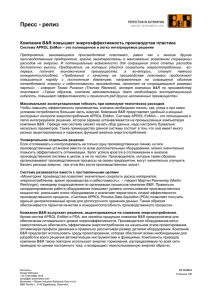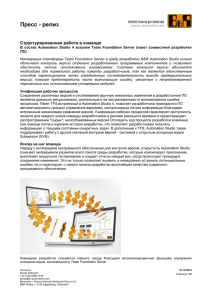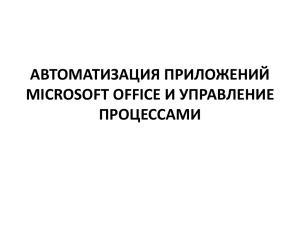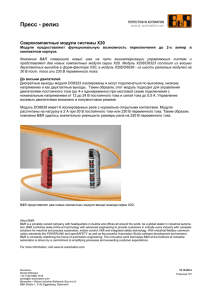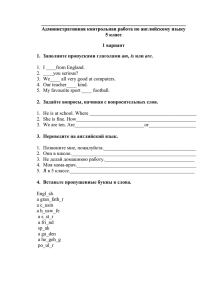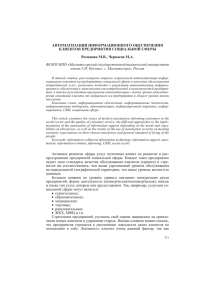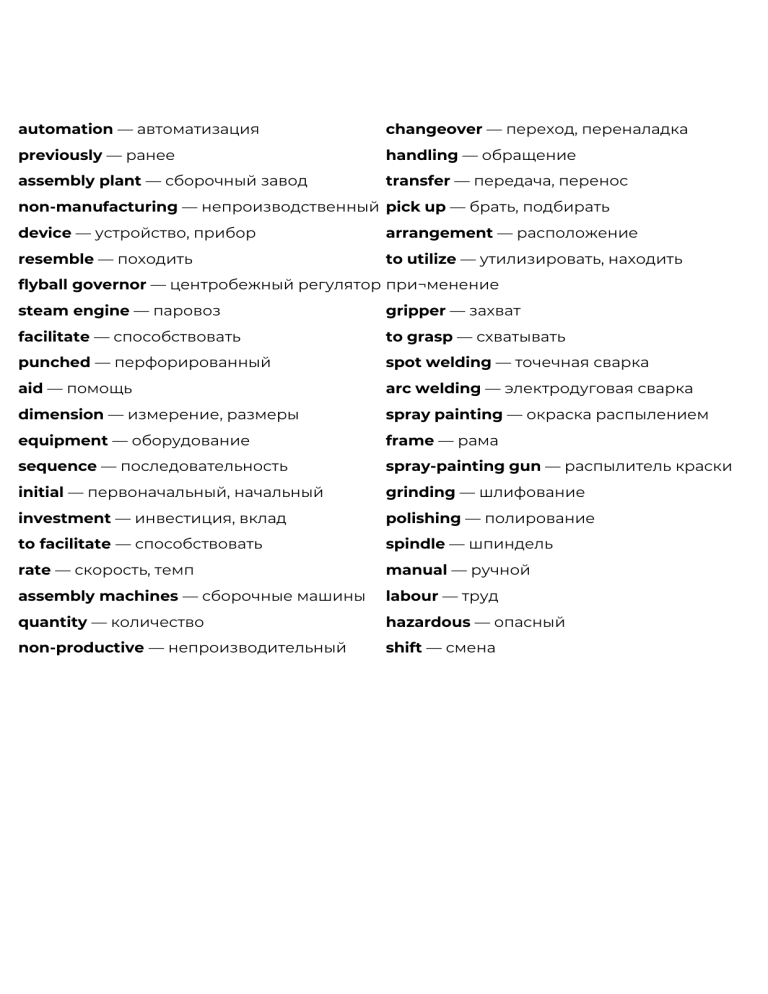
automation — автоматизация changeover — переход, переналадка previously — ранее handling — обращение assembly plant — сборочный завод transfer — передача, перенос non-manufacturing — непроизводственный pick up — брать, подбирать device — устройство, прибор arrangement — расположение resemble — походить to utilize — утилизировать, находить flyball governor — центробежный регулятор при¬менение steam engine — паровоз gripper — захват facilitate — способствовать to grasp — схватывать punched — перфорированный spot welding — точечная сварка aid — помощь arc welding — электродуговая сварка dimension — измерение, размеры spray painting — окраска распылением equipment — оборудование frame — рама sequence — последовательность spray-painting gun — распылитель краски initial — первоначальный, начальный grinding — шлифование investment — инвестиция, вклад polishing — полирование to facilitate — способствовать spindle — шпиндель rate — скорость, темп manual — ручной assembly machines — сборочные машины labour — труд quantity — количество hazardous — опасный non-productive — непроизводительный shift — смена Text A: «AUTOMATION» Automation is the system of manufacture performing certain tasks, previously done by people, by machines only. The sequences of operations are controlled automatically. The most familiar example of a highly automated system is an assembly plant for automobiles or other complex products. The term automation is also used to describe non-manufacturing systems in which automatic devices can operate independently of human control. Such devices as automatic pilots, automatic telephone equipment and automated control systems are used to perform various operations much faster and better than could be done by people. Automated manufacturing had several steps in its development. Mechanization was the first step necessary in the development of automation. The simplification of work made it possible to design and build machines that resembled the motions of the worker. These specialized machines were motorized and they had better production efficiency. Industrial robots, originally designed only to perform simple tasks in environments dangerous to human workers, are now widely used to transfer, manipulate, and position both light and heavy workpieces performing all the functions of a transfer machine. In the 1920s the automobile industry for the first time used an integrated system of production. This method of production was adopted by most car manufacturers and became known as Detroit automation. The feedback principle is used in all automatic-control mechanisms when machines have ability to correct themselves. The feedback principle has been used for centuries. An outstanding early example is the flyball governor, invented in 1788 by James Watt to control the speed of the steam engine. The common household thermostat is another example of a feedback device. Using feedback devices, machines can start, stop, speed up, slow down, count, inspect, test, compare, and measure. These operations are commonly applied to a wide variety of production operations. Computers have greatly facilitated the use of feedback in manufacturing processes. Computers gave rise to the development of numerically controlled machines. The motions of these machines are controlled by punched paper or magnetic tapes. In numerically controlled machining centers machine tools can perform several different machining operations. More recently, the introduction of microprocessors and computers have made possible the development of computer-aided design and computer-aided manufacture (CAD and CAM) technologies. When using these systems, a designer draws a part and indicates its dimensions with the help of a mouse, light pen, or other input device. After the drawing has been completed the computer automatically gives the instructions that direct a machining center to machine the part. Another development using automation are the flexible manufacturing systems (FMS). A computer in FMS can be used to monitor and control the operation of the whole factory. Automation has also had an influence on the areas of the economy other than manufacturing. Small computers are used in systems called word processors, which are rapidly becoming a standard part of the modern office. They are used to edit texts, to type letters and so on. Automation in Industry Many industries are highly automated or use automation technology in some part of their operation. In communications and especially in the telephone industry dialing and transmission are all done automatically. Railways are also controlled by automatic signaling devices, which have sensors that detect carriages passing a particular point. In this way the movement and location of trains can be monitored. Not all industries require the same degree of automation. Sales, agriculture, and some service industries are difficult to automate, though agriculture industry may become more mechanized, especially in the processing and packaging of foods. The automation technology in manufacturing and assembly is widely used in car and other consumer product industries. Nevertheless, each industry has its own concept of automation that answers its particular м needs. Текст А: "АВТОМАТИЗАЦИЯ" Автоматизация — это система производства, выполняющая определенные задачи, ранее выполняемые людьми, только машинами. Последовательность операций контролируется автоматически. Наиболее знакомым примером высокоавтоматизированной системы является сборочный завод для автомобилей или других сложных изделий. Термин "автоматизация" также используется для описания непроизводственных систем, в которых автоматические устройства могут работать независимо от человеческого контроля. Такие устройства, как автоматические пилоты, автоматическое телефонное оборудование и автоматизированные системы управления, используются для выполнения различных операций гораздо быстрее и лучше, чем это могли бы сделать люди. Автоматизированное производство имело несколько этапов в своем развитии. Механизация была первым шагом, необходимым для развития автоматизации. Упрощение труда позволило спроектировать и построить машины, которые напоминали движения рабочего. Эти специализированные машины были моторизованы, и они имели более высокую эффективность производства. Промышленные роботы, первоначально предназначенные только для выполнения простых задач в условиях, опасных для человека, сегодня широко используются для перемещения, манипулирования и позиционирования как легких, так и тяжелых заготовок, выполняя все функции передаточной машины. В 1920-х годах автомобильная промышленность впервые использовала интегрированную систему производства. Этот метод производства был принят большинством производителей автомобилей и стал известен как детройтская автоматизация. Принцип автоматического обратной управления, связи когда используется машины во обладают всех механизмах способностью к самокоррекции. Принцип обратной связи использовался на протяжении веков. Выдающимся ранним примером является маховик, изобретенный в 1788 году Джеймсом Уаттом для управления скоростью парового двигателя. Обычный бытовой термостат - еще один пример устройства обратной связи. С помощью останавливаться, устройств ускоряться, обратной связи замедляться, машины считать, могут запускаться, проверять, тестировать, сравнивать и измерять. Эти операции обычно применяются в самых разных производственных операциях. Компьютеры значительно облегчили использование обратной связи в производственных процессах. Компьютеры привели к созданию станков с числовым программным управлением. Движения этих станков контролируются перфорированной бумагой или магнитными лентами. В обрабатывающих центрах с числовым программным управлением станки могут выполнять несколько различных операций обработки. Совсем недавно внедрение микропроцессоров и компьютеров позволило разработать технологии автоматизированного проектирования и автоматизированного производства (CAD и CAM). При использовании этих систем конструктор рисует деталь и указывает ее размеры с помощью мыши, светового пера или другого устройства ввода. После завершения чертежа компьютер автоматически выдает инструкции, которые направляют обрабатывающий центр на обработку детали. Еще одной разработкой, использующей автоматизацию, являются гибкие производственные системы (FMS). Компьютер в FMS может использоваться для мониторинга и управления работой всего завода. Автоматизация оказала влияние и на другие сферы экономики, помимо производства. Малые компьютеры используются в системах, называемых текстовыми процессорами, которые быстро становятся стандартной частью современного офиса. Они используются для редактирования текстов, набора писем и так далее. Автоматизация в промышленности Многие отрасли промышленности высоко автоматизированы или используют технологию автоматизации в той или иной части своей деятельности. В сфере связи, особенно в телефонной промышленности, набор и передача номера осуществляются автоматически. Железные дороги также управляются автоматическими сигнальными устройствами, которые имеют датчики, определяющие прохождение вагонов через определенную точку. Таким образом, можно отслеживать движение и местоположение поездов. Не все отрасли требуют одинаковой степени автоматизации. Сбыт, сельское хозяйство и некоторые сферы услуг трудно поддаются автоматизации, хотя сельскохозяйственная промышленность может стать более механизированной, особенно в сфере переработки и упаковки продуктов питания. Технология автоматизации производства и сборки широко используется в автомобильной и других отраслях производства потребительских товаров. Тем не менее, каждая отрасль имеет свою собственную концепцию автоматизации, отвечающую ее конкретным производственным потребностям. 1. How is the term automation defined in the text? - Automation is the system of manufacture performing certain tasks, previously done by people, by machines only. 2. What is the most «familiar example» of automation given in the text? - An assembly plant for automobiles or other complex products. 3. What was the first step in the development of automaton? – Mechanization. 4. What were the first robots originally designed for? - To perform simple tasks in environments dangerous to human workers. 5. What was the first industry to adopt the new integrated system of production? Automobile industry. 6. What is feedback principle? - Using feedback devices, machines can start, stop, speed up, slow down, count, inspect, test, compare, and measure. 7. What do the abbreviations CAM and CAD stand for? – CAD - Computer-Aided Design, CAM - Computer-Aided Manufacture. 8. What is FMS? – These are flexible manufacturing systems, used to monitor and control the operation of the whole factory. 9. What industries use automation technologies? - Telephone industry, railways, cars and other consumer product industries. 1. Автоматические устройства - automatic devices. 2. Автоматизированное производство - automated manufacturing. 3. Выполнять простые задачи – perform simple tasks. 4. Как легкие, так и тяжелые детали - both light and heavy workpieces 5. Интегрированная система производства - integrated system of production 6. Принцип обратной связи - the feedback principle 7. Механизм может разгоняться и тормозить - machines can speed up and slow down. 8. Компьютер автоматически посылает команды - computer automatically gives the instructions. 9. Высокоавтоматизированная система - highly automated system. 10. Непроизводственная система – non-manufacturing system. Text В: «TYPES OF AUTOMATION» Applications of Automation and Robotics in Industry Manufacturing is one of the most important application area for automation technology. There are several types of automation in manufacturing. The examples of automated systems used in manufacturing are described below. 1. Fixed automation, sometimes called «hard automation» refers to automated machines in which the equipment configuration allows fixed sequence of processing operations. These machines are programmed by their design to make only certain processing operations. They are not easily changed over from one product style to another. This form of automation needs high initial investments and high production rates. That is why it is suitable for products that are made in large volumes. Examples of fixed automation are machining transfer lines found in the automobile industry, automatic assembly machines and certain chemical processes. 2. Programmable automation is a form of automation for producing products in large quantities, ranging from several dozen to several thousand units at a time. For each new product the production equipment must be reprogrammed and changed over. This reprogramming and changeover take a period of non-productive time. Production rates in programmable automation are generally lower than in fixed automation, because the equipment is designed to facilitate product changeover rather than for product specialization. A numerical-control machine-tool is a good example of programmable automation. The program is coded in computer memory for each different product style and the machine-tool is controlled by the computer programme. 3. Flexible automation is a kind of programmable automation. Programmable automation requires time to re-program and change over the production equipment for each series of new product. This is lost production time, which is expensive. In flexible automation the number of products is limited so that the changeover of the equipment can be done very quickly and automatically. The reprogramming of the equipment in flexible automation is done at a computer terminal without using the production equipment itself. Flexible automation allows a mixture of different products to be produced one right after another. Текст В: "ВИДЫ АВТОМАТИЗАЦИИ" Применение автоматизации и робототехники в промышленности Производство является одной из наиболее важных областей применения технологии автоматизации. производстве. Ниже Существует описаны несколько примеры типов автоматизации автоматизированных в систем, используемых в производстве. 1. Фиксированная автоматизацией", конфигурация автоматизация, относится к оборудования иногда называемая автоматизированным позволяет станкам, выполнять "жесткой в которых фиксированную последовательность операций обработки. Эти машины запрограммированы своей конструкцией на выполнение только определенных операций обработки. Их нелегко переналадить с одного вида продукции на другой. Эта форма автоматизации требует больших первоначальных инвестиций и высоких темпов производства. Поэтому она подходит для продукции, которая производится в больших объемах. Примерами стационарной автоматизации являются линии передачи обработки, используемые в автомобильной промышленности, автоматические сборочные машины и некоторые химические процессы. 2. Программируемая автоматизация — это форма автоматизации для производства продукции в больших количествах, от нескольких десятков до нескольких тысяч производственное единиц одновременно. оборудование должно Для каждого быть нового продукта перепрограммировано и переналажено. Перепрограммирование и переналадка занимают определенный период непроизводительного времени. Темпы производства в программируемой автоматизации обычно ниже, чем в фиксированной автоматизации, поскольку оборудование разработано для облегчения переналадки, а не для специализации продукции. Хорошим примером программируемой автоматизации является станок с числовым программным управлением. Программа кодируется в памяти компьютера для каждого вида продукции, и станок управляется компьютерной программой. 3. Гибкая автоматизации. автоматизация — Программируемая это разновидность автоматизация программируемой требует времени на перепрограммирование и переналадку производственного оборудования для каждой серии нового продукта. Это потерянное производственное время, которое стоит дорого. В гибкой автоматизации количество продуктов ограничено, поэтому переналадка оборудования может быть выполнена очень быстро и автоматически. Перепрограммирование оборудования при гибкой автоматизации осуществляется с помощью компьютерного терминала без использования самого производственного оборудования. Гибкая автоматизация позволяет производить смесь различных продуктов один за другим. 1. What is the most important application of automation? – Manufacturing. 2. What are the types of automation used in manufacturing? - Fixed automation, programmable automation, flexible automation. 3. What is fixed automation? - Sometimes called «hard automation» refers to automated machines in which the equipment configuration allows fixed sequence of processing operations. 4. What are the limitations of hard automation? - These machines are programmed by their design to make only certain processing operations. They are not easily changed over from one product style to another. 5. What is the best example of programmable automation? - Numerical-control machine-tool. 6. What are the limitations of programmable automation? - For each new product the production equipment must be reprogrammed and changed over. 7. What are the advantages of flexible automation? - In flexible automation the number of products is limited so that the changeover of the equipment can be done very quickly and automatically. 8. Is it possible to produce different products one after another using automation technology? – Yes, flexible automation allows a mixture of different products to be produced one right after another. 1. Сфера применения - application area 2. Фиксированная последовательность операций - fixed sequence of operations. 3. Автоматические сборочные машины - automatic assembly machines. 4. Определенные химические процессы - certain chemical processes. 5. Станок с числовым программным управлением - numerical-control machine-tool 6. Потерянное производственное время - lost production time. 7. Разнообразная продукция - variety of production. Text C: «ROBOTS IN MANUFACTURING» Today most robots are used in manufacturing operations. The applications of robots can be divided into three categories: 1. material handling 3. assembly and inspection. 2. processing operations Material-handling is the transfer of material and loading and unloading of machines. Material-transfer applications require the robot to move materials or work parts from one to another. Many of these tasks are relatively simple: robots pick up parts from one conveyor and place them on another. Other transfer operations are more complex, such as placing parts in an arrangement that can be calculated by the robot. Machine loading and un-loading operations utilize a robot to load and unload parts. This requires the robot to be equipped with a grip-per that can grasp parts. Usually the gripper must be designed specifically for the particular part geometry. In robotic processing operations, the robot manipulates a tool to perform a process on the work part. Examples of such applications include spot welding, continuous arc welding and spray painting. Spot welding of automobile bodies is one of the most common applications of industrial robots. The robot positions a spot welder against the automobile panels and frames to join them. Arc welding is a continuous process in which robot moves the welding rod along the welding seam. Spray painting is the manipulation of a spray-painting gun over the surface of the object to be coated. Other operations in this category include grinding and polishing in which a rotating spindle serves as the robot's tool. The third application area of industrial robots is assembly and inspection. The use of robots in assembly is expected to increase because of the high cost of manual labor. But the design of the product is an important aspect of robotic assembly. Assembly methods that are satisfactory for humans are not always suitable for robots. Screws and nuts are widely used for fastening in manual assembly, but the same operations are extremely difficult for a one-armed robot. Inspection is another area of factory operations in which the utilization of robots is growing. In a typical inspection job, the robot positions a sensor with respect to the work part and determines whether the part answers the quality specifications. In nearly all industrial robotic applications, the robot provides a substitute for human labor. There are certain characteristics of industrial jobs performed by humans that can be done by robots: 1. the operation is repetitive, involving the same basic work motions every cycle, 2. the operation is hazardous or uncomfortable for the human worker (for example: spray painting, spot welding, arc welding, and certain machine loading and unloading tasks), 3. the workpiece or tool is too heavy and difficult to handle, 4. the operation allows the robot to be used on two or three shifts. Текст C: "РОБОТЫ В ПРОИЗВОДСТВЕ" Сегодня большинство роботов используется в производственных операциях. Применение роботов можно разделить на три категории: 1. обработка материалов 3. сборка и контроль. 2. операции обработки Обработка материалов — это перемещение материалов, а также загрузка и разгрузка машин. В приложениях, связанных с перемещением материалов, робот должен перемещать материалы или рабочие детали с одного места на другое. Многие из этих задач относительно просты: роботы забирают детали с одного конвейера и помещают их на другой. Другие операции по перемещению более сложны, например, размещение деталей в порядке, который может быть рассчитан роботом. В операциях загрузки и разгрузки машин используется робот для загрузки и выгрузки деталей. Для этого робот должен быть оснащен захватом, который может захватывать детали. Обычно захват должен быть разработан специально для конкретной геометрии детали. При роботизированной обработке робот манипулирует инструментом для выполнения технологического процесса на детали. Примерами такого применения являются точечная сварка, непрерывная дуговая сварка и окраска распылением. Точечная сварка автомобильных кузовов является одним из наиболее распространенных применений промышленных роботов. Робот устанавливает аппарат точечной сварки на панели и рамы автомобиля, чтобы соединить их. Дуговая сварка — это непрерывный процесс, в котором робот перемещает сварочный стержень вдоль сварочного шва. Окраска распылением — это манипуляции распылительным пистолетом над поверхностью объекта, на который необходимо нанести покрытие. Другие операции в этой категории включают шлифовку и полировку, в которых вращающийся шпиндель служит инструментом робота. Третья область применения промышленных роботов - сборка и контроль. Ожидается, что использование роботов при сборке будет расти из-за высокой стоимости ручного труда. Однако дизайн изделия является важным аспектом роботизированной сборки. Методы сборки, удовлетворительные для человека, не всегда подходят для роботов. Винты и гайки широко используются для крепления при ручной сборке, но эти же операции чрезвычайно сложны для однорукого робота. Инспекция - еще одна область заводских операций, в которой использование роботов растет. При типичном контроле робот позиционирует датчик относительно детали и определяет, соответствует ли деталь техническим условиям качества. Почти во всех промышленных роботизированных приложениях робот заменяет человеческий труд. Существуют определенные характеристики промышленных работ, выполняемых людьми, которые могут быть выполнены роботами: 1. работа повторяется, каждый цикл включает одни и те же основные рабочие движения, 2. работа опасна или неудобна для человека (например, окраска распылением, точечная сварка, дуговая сварка и некоторые задачи по загрузке и разгрузке машин), 3. заготовка или инструмент слишком тяжелые и с ними трудно обращаться, 4. операция позволяет использовать робота в две или три смены. 1. How are robots used in manufacturing? - Material handling, processing operation assembly and inspection. 2. What is «material handling»? - Is the transfer of material and loading and unloading of machines. 3. What does a robot need to be equipped with to do loading and unloading operations? - Gripper that can grasp parts. 4. What does robot manipulate in robotic processing operation? - Tool to perform a process on the work part. 5. What is the most common application of robots in automobile manufacturing? - Spot welding. 6. What operations could be done by robot in car manufacturing industry? - Arc welding, spray painting, grinding and polishing. 7. What are the main reasons to use robots in production? - Because of the high cost of manual labor. 8. How can robots inspect the quality of production? - Robot positions a sensor with respect to the work part and determines whether the part answers the quality specifications. 9. What operations could be done by robots in hazardous or uncomfortable for the human workers conditions? - 1. the operation is repetitive, involving the same basic work motions every cycle, 2. the operation is hazardous or uncomfortable for the human worker (for example: spray painting, spot welding, arc welding, and certain machine loading and unloading tasks), 3. the workpiece or tool is too heavy and difficult to handle, 4. the operation allows the robot to be used on two or three shifts. 1. Существует несколько различных сфер использования автоматизации в производстве - There are several different uses for automation in production. 2. Для использования жесткой автоматизации необходимы большие инвестиции. – For using hard automation requires high investments. 3. Жесткая автоматизация широко используется в химической промышленности. – Fixed automation widely used in the chemical industry. 4. Станки с числовым программным управлением — хороший пример программируемой автоматизации. – Numerical control machine-tools - a good example of programmable automation. 5. Гибкая автоматизация делает возможным перепрограммирование оборудования. – Flexible automation makes it possible to reprogram the equipment. 6. Время простоя оборудования оборачивается большими убытками. - Equipment downtime is costly. 7. Использование гибкой автоматизации делает возможным производство разнообразной продукции. – The use of flexible automation makes it possible to produce a variety of products.
